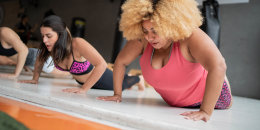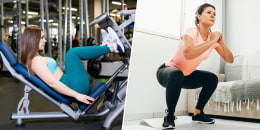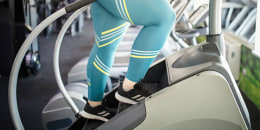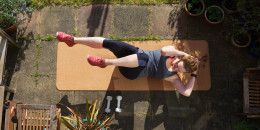As a personal trainer, I frequently am asked by my clients about the exercises that burn the most calories. I usually respond by explaining that other indicators — like strength, endurance and heart rate — can be more important signs that you've done a good workout.
While calories are a common measurement for energy input and output, calorie burn doesn’t necessarily indicate the quality of a workout.
What's more, the common “calories in, calories out” model is an outdated approach to weight loss, especially for women with hormonal fluctuations, since each person’s metabolic rate is different. Cutting calories can sometimes backfire because when you don’t eat enough, you slow down your metabolism.
Sign up for our Start TODAY newsletter to receive daily inspiration sent to your inbox — and join us on Instagram!
So if you're focused on calorie burn for weight loss purposes, know exercise of any kind can help you to maintain weight loss, according to the Mayo clinic, and losing weight without physical exercise can cause you to become weaker.
While burning calories through exercise boosts metabolism, how you burn calories can be just as important as how many you burn.
If you are sweating, out of breath and have trouble carrying on a conversation during your workout, that tells you more about the effort you are putting in than the calorie burn readout on a piece of exercise equipment.
Most people think cardio exercise is best for weight loss, but I recommend a combination of cardio and strength training to build muscle. This helps you to burn fat and calories when you are at rest, and for long after your workout is over.
Exercises that burn the most calories
If you log calorie burn as part of your fitness and nutrition metrics, here are some general statistics for common exercises for a person weighing about 150 pounds:
Yoga
- 30 minutes of Hatha yoga: 145 calories
Yoga boasts important benefits like increasing flexibility, improving heart health, reducing pain and improving mental health. Hatha yoga — a style of yoga done at a slower, more controlled pace — burns almost 150 calories per 30-minute session according to the USDA. Balance and flexibility work as an important part of a healthy workout routine and the American Heart Association (AHA) recommends incorporating it weekly. Expect to burn more calories with vinyasa yoga, which is a style of yoga that connects each movement with your breath and moves at a faster pace. New to yoga? Try it with this 5-minute yoga flow to wake you up in the morning or 10 chair yoga poses.
Jumping rope
- 30 minutes of jump rope at a moderate to fast pace: about 375 calories
You can burn around 375 calories in 30 minutes, according to the AHA, and jumping rope can help you lose fat, build muscle and improve motor skills and agility. You also have to use your core for balance, so it’s a good workout for your abs. Plus, jump ropes are inexpensive when it comes to exercise equipment. Give it a try with this 15-minute jump rope workout for beginners.
Running
- 30 minutes at 10-12 mph: about 330 calories
Numerous studies have shown running has both physical and mental health benefits. Runners tend to live longer and are less likely to develop cardiovascular disease. And jogging is an efficient calorie burner that can torch about 330 calories in 30 minutes, according to the AHA. Increase your pace and you elevate the calorie burn even more. If you’re a walker, try two minute jogging sprints during your walk to intensify your workout routine.
Indoor cycling
- 30 minutes on a stationary bike at a moderate to intense pace: 250-380 calories
Indoor cycling with Peloton or group classes at the gym are a great cardiovascular workout, and you can burn anywhere from 250-380 calories per half-hour cycling session depending on the intensity, according to the United States Department of Agriculture (USDA).
If you’re new to the stationary bike, here’s what you need to know before you hop on: Make sure the seat and handlebars are properly set up so you don’t injure yourself. If you prefer to take your bike on the move, a 30-minute ride at a moderate pace burns about 205 calories, according to the AHA.
Power walking
- 30 minutes walking (very brisk pace): 306 calories
Good news for those who dislike running: According to the American Council on Exercise (ACE) walking at a fast pace of 5 mph burns almost as many calories as jogging. Power walking entails moving at a quick speed and getting your arms involved, which burns more calories than walking at a slower pace. On days when you need to take things a little slower, walking at a moderate pace still burns 160 calories in 30 minutes, according to the AHA. Walking at any speed has important health benefits. In fact, a recent study found that walking 4,000 steps a day started to reduce the risk of dying from any cause, while walking just 2,337 steps a day reduced the risk of dying from cardiovascular disease.
Calisthenics
- 30 minutes calisthenics: 272 calories
Calisthenics is strength training that uses just your body weight. Bodyweight strength exercises are a great way to build muscle and lose weight, if that's your goal. Plus, the AHA recommends incorporating strength workouts into your routine at least twice a week. Intense calisthenics, like the exercises done in bootcamps and HIIT workouts, can burn 272 calories in a 30-minute session, according to ACE. Less intense calisthenics done at a more moderate pace burn 119 calories in 30 minutes.
Stair climbing
- 30 minutes climbing stairs: 272 calories
Most people have seen the leering tower next to the treadmills. The stair climber features a rotating belt of stairs with handlebars that allows you to climb a never-ending staircase. If you're a fan of sweating it out on the StairMaster, good news: That hard work burns some serious calories. The stair climber is a cardio and strength workout that recruits your entire body. Climbing stairs can burn 272 calories in 30 minutes, according to ACE.
Dance cardio
- 30 minutes dance cardio: 190 calories
Dance cardio has become a popular workout for its ability to make cardio exercise fun. According to ACE, a 30-minute dance session — done at a fast pace — burns almost 200 calories. If your favorite dance cardio class incorporates HIIT training or bodyweight strength moves, you're likely burning even more. Give it a try with this fun 10-minute dance cardio routine or this 28-minute class from celebrity trainer Isaac Boots.
Weight training
- 30 minutes weight training: 100-200 calories
It's recommended to add strength training to your routine twice a week for a reason: Building strength in your muscles improves bone density, increases flexibility in the joints, improves balance, prevents injury, speeds up the metabolism and burns calories. According to ACE, a 30-minute weight-training session can burn 100-200 calories, depending on the intensity of your movements. Don't forget that muscle burns more calories than fat, which means that by building muscle you're boosting your metabolism and burning more calories at rest!
Is it good to burn a lot of calories?
The numbers above may lead someone to ditch yoga for a spin class or force themselves to run instead of walk. But how many calories we burn doesn’t reflect what our body needs. Yes, you can hop on your spin bike and burn more calories than a yoga class, but you’ll be foregoing flexibility, toning and mental health benefits that your body may be craving.
The best workout plan is one that makes you feel good. I never recommend sacrificing that for the sake of burning more calories. I encourage my clients to feel empowered and to tap into what their bodies need. One day that may be a leisurely walk, and the next it may be an intense spin class — and both are solid workout choices.
Choosing a calorie burn goal
Just like daily steps, setting a calorie-burn goal can turn your exercise into a game and motivate you to get moving. However, the number of calories you want to burn through exercise will vary based on your diet, body composition and goals. (Are you trying to lose weight? Improve endurance?) So if you are going to closely monitor your calorie burn and aim to hit a certain number, I do suggest working with a trainer to determine what a healthy calorie burn goal is for you.
I also want to warn against becoming hyper-focused on calories — this can spiral into an unhealthy relationship with food and exercise. If tracking calories burned is fun for you, that’s fine. But if it becomes another stressor or you find yourself feeling discouraged when you don’t burn a certain amount, ditch it.
Track non-scale victories, too
This is the main question I always ask: Do you feel like your workout routine is helping you reach your goals? Calories are only one way to track the effectiveness of a workout.
If you are seeing other non-scale victories, like your clothes fit better or your energy levels and sleep have improved, those are important signs your workouts are working for you. However, if you are someone who overeats and consumes more calories than your body needs, tracking how many calories you burn can be helpful in becoming more aware of how you fuel and move your body.
Having a general sense of how many calories you are burning when moving your body is great. But remember: It is only one measure of a workouts intensity and effectiveness and shouldn’t be the end-all-be-all when it comes to rating a workout or choosing which type of exercise to do. For a well-rounded workout routine, focusing on how your body feels and the progress you’re making toward your goals over time is a much healthier approach.










